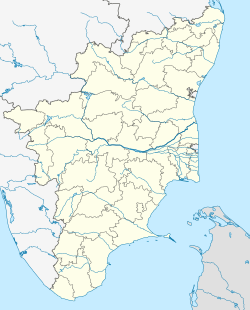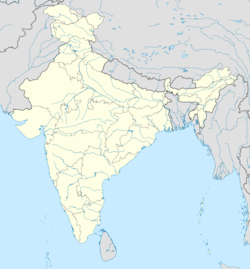Kayalpatnam
Kayalpattinam | |
|---|---|
| Nickname: Little Makkah | |
| Coordinates: 8°33′59″N 78°6′59″E / 8.56639°N 78.11639°E | |
| Country | |
| State | Tamil Nadu |
| Government | |
| • Body | Kayalpattinam Municipality |
| Area | |
• Total | 12.5 km2 (4.8 sq mi) |
| Population (2011) | |
• Total | 40,588 |
| • Density | 3,200/km2 (8,400/sq mi) |
| Demonym(s) | Kayalar, Kayalite |
| Languages | |
| • Official | Tamil |
| Time zone | UTC+5:30 (IST) |
| PIN | 628204 |
| Telephone code | 04639 |
| Vehicle registration | TN 92 (Thiruchendur RTO) |
| Nearest city | Thoothukudi |
| Sex ratio | 1000:1177 ♂/♀ |
| Literacy | 92.71% |
| Lok Sabha constituency | Thoothukudi Formerly with Tiruchendur |
| Vidhan Sabha constituency | Tiruchendur |
| Civic Agency | Kayalpattinam Municipality |
| Climatei | Humid (Köppen) |
Kayalpatnam (also known as Kayalpattinam or Kayalpattanam) is a municipality in the Thoothukudi district in the Indian state of Tamil Nadu. As of 2011, the town had a population of 40,588.
History
[edit]Also known as Kayal, it is referred to in Marco Polo's[1] travel diaries dating to 1298 AD. Korkai,[2] Vaguthai or Kayal was an ancient port dating to the 1st centuries of the common era and was contemporaneous to the existence of Kollam, another Pandyan port. Kollam served the Pandyas on the west coast while Korkai/Kayal served them on the east coast connecting them to Ceylon and the pearl fisheries in the Gulf of Mannar facing the Tirunelveli Coast. Arab traders from Egypt and Yemen landed at the port of Korkai (present-day Kayalpatnam). Some traders migrated to Adirampattinam. Strong trading connections existed with Sri Lanka. There exist a strong cultural connection between Kayalpattinam, Adirampattinam and Kilakarai. Most of the Muslims here are matrilocal residents. The ancient port had trade connections with Egypt, Rome and Greece.
Ibn Battuta, the Muslim Moroccan explorer has mentioned about Kayalpattinam (as called as Fatan) in his travel node The Rihla (lit. "Journey"). There exist a strong cultural connection exists between Kayalpatnam, Adirampattinam and Kilakarai.
Kayalpatnam now has many mosques. Noted photographer Benoy Behl has made a film on the Islamic architecture of India, and visited a Kayalpatnam mosque.[3]
In the Indian Independence Movement
[edit]In the Freedom Struggle, Kayalpattinam, a part of Tiruchendur Taluk, played a vibrant role. Many patriots from Kayalpattinam participated in the Civil Disobedience Movement, the Individual Satyagraha, and the Quit India Movement.
Toddy shop picketing holds significant historical importance in Kayalpattinam. In 1930, Mahatma Gandhi presented a set of Eleven Demands to the British Viceroy, Lord Irwin, addressing key economic and social grievances of the Indian people. These demands included the abolition of the salt tax, reduction of land revenue, and prohibition of intoxicating drinks. Among them, the call for the closure of liquor shops stood out as a reflection of Gandhi’s commitment to moral and social reform through non-violent means. Kayalpattinam—today one of the rare towns in Tamil Nadu without a liquor shop—was not always so. During British rule, toddy shops operated in the town. It was against this backdrop that patriots like L. K. Sheikh Muhammed (Kayal Gandhi), R. Venkatrama Mudaliar (karnam of Kayalpatnam), and others took a principled stand. Inspired by Gandhi’s call for prohibition during the renewed phase of the Civil Disobedience Movement in 1932, they organized toddy shop picketing in Kayalpattinam[4].These protests were not only a direct challenge to colonial authority but also a powerful moral statement rooted in Gandhian ideals of self-restraint, simplicity, and social responsibility.
Freedom Fighters of Kayalpatnam
[edit]One of the prominent freedom fighters from the town was L.K. Sheikh Muhammed, popularly known as the 'Kayal Gandhi'[5] for his simple and dedicated life, and his active involvement in various satyagrahas, including toddy shop picketing[5]. He was widely respected for his unwavering commitment to Gandhian principles. He famously refused to accept the freedom fighters' pension and other benefits offered by the government, insisting that such assistance should be reserved for the truly needy. Throughout his life, he embraced simplicity and self-reliance, continuing to do his own chores even in old age — a true embodiment of Gandhian ideals.

Another Important freedom fighter of Kayalpattinam was R. Venkatrama Mudaliar, who was the Karnam (Village Accountant) of Kayalpatnam. He resigned his karnam job with the onset of Civil Disobedience Movement and took part in toddy shop picketing at Kayalpattinam[6][7][8] along with L.K Sheik Muhammed and other patriots, for this Venkatraman was arrested and Sentenced under Section 4 of the ordinance act of 1932 and kept at Kokkirakulam sub-jail for four months and later at Tiruchirapalli central Jail for a year from 1932 to 1933.[9][10][11] He was brutally tortured in prison, where the police kicked him in the stomach with heavy boots. He bore these atrocities with unwavering courage, a testament to his spirit as an ardent patriot and a true freedom-loving soul. Later, he took part in the 1941 Individual Satyagraha from Tiruchendur [12][13]. and also he was arrested by the Malabar Special Police (M.S.P) for his active participation in the Quit India Movement, during the investigation of Kulasekarapattnam Conspiracy Case in 1942, though he did not involve in the conspiracy that killed the Assisant Inspector of Salt at Kulasekarapattnam[11][14]. In addition to his role in the freedom struggle, R. Venkatraman also contributed to the welfare of his community in practical ways. He took part in efforts to bring clean and reliable drinking water to the town of Kayalpattinam—a critical need in the region at the time.



Also the Town had produced numerous freedom fighters like M.K.M Shamsudeen (who met Pandit Jawaharlal Nehru and his family at Srilanka on 24 July 1939), M.K Syed Ahamad (who was the member of Jilla Board and President of the Third International Islamic Tamil Literature Research Conference), Hajji L.K Leppai Thambi (played major role in bringing good drinking water to kayalpattnam, considered as the father of Education of the Kayalpatnam Town), A.K.S Syed Ahmad Hajji, A.K.S Sahul Hameed Hajji, Salai S.M. Sali Haji, Janab M.K. Muhammad Thambi Marakkar, M.T.S. Muhammad Thambi (District Board Member), M.K. Abdul Qadir, P.M. Pitchai Thambi Marakkar alias Muhammad Ibrahim, A.K. Hasan Marakkar Thambi, S.M. Zakariya (Collaborated with Periyar E.V. Ramasamy), Paalayam Samsutheen, Haji S.O. Habeeb, Haji S.A. Habeeb, Seyyid Ahmad Maulana (Editor of Al-Hidhaya newspaper),[15] Seyyid Ali Maulana, Seyyid Muhyiddin Maulana, Haji V.M.S. Labbai, (Former Minority Division President, Tirunelveli District Congress Committee; President of Town Congress Committee in1990), S.K. Muhammad Labbai, Sri K. Subramanian, Dr. R. Selvanathan R.I.M.P., Saamikkannu Achari, Janab Haji B.S.A. Kabeer, A.S. Muhammad Nooku, Haji A.S. Saleh, Sulaiman Muhammad Muhyiddin, Qadir Sahib alias Khateeb Muhammad Saleh, Pattah Magdhoom Meeraleppai (Worked with Veteran leader Rajaji).[4] All these men had devoted their lives to the nationalist cause.
Demographics
[edit]According to 2011 census, Kayalpattinam had a population of 40,588 with a sex-ratio of 1,082 females for every 1,000 males, much above the national average of 929.[16] A total of 4,995 were under the age of six, constituting 2,548 males and 2,447 females. Scheduled Castes and Scheduled Tribes accounted for 7.37% and .01% of the population respectively. The average literacy of the town was 81.3%, compared to the national average of 72.99%.[16] The town had a total of : 9417 households. There were a total of 11,414 workers, comprising 17 cultivators, 27 main agricultural labourers, 206 in house hold industries, 10,717 other workers, 447 marginal workers, 9 marginal cultivators, 4 marginal agricultural labourers, 30 marginal workers in household industries and 404 other marginal workers.[17] Tamil is the predominant language, spoken by 99.72% of the population.
Islam is the dominant religion in this municipality. As per the religious census of 2011, Kayalpattinam had 26.34% Hindus, 67.24% Muslims, 6.36% Christians, 0.01% following other religions.[18]
Culture
[edit]Most Muslims here follow Shafi Madhab with Qadiriyya and Shadhiliya Tariqa (Sufi order) Qadiriyya tariqa connected to Mahlara and Shadhiliya tariqa connected to zaviya Faasiyatush shadhiliya Tariqa. Headquarters of this tariqa[19] in India Zaviathul Fasiyathus shathulia is located here. There are few followers of ahle hadees also. Maqbara of Kazi Syed Alauddin brother of Kazi Syed Tajuddin the fore father of Madurai Maqbara Hazrats'[20] and of all the Syeds living in Kazimar Street, Madurai is located here.
Islamic Educational institutions
[edit]- Al Madrasatul Fasiyyah
- Al Mahlarathul Qadhiriyyah
- Al Madrasatul Hamidhiyya
- Madrasathul Azhar li Thahfeezil Quraanil Kareem
- Da'wathul Huda
- Aroosul Jannah Women's Islamic college
- Ayisha Siddiqua women's Islamic college
- Al Kulliyathun Nasuhiyya women's Islamic college
- Muaskarur Rahman Women's Islamic college
- Muaskarur Rahman Hifz college for Women's
References
[edit]- ^ M. Polo refers in fact to Pazhaiyakayal (Old Payal), which is 15 km north of actual Kayalpatnam. See Roderich Ptak, Yuan and Early Ming Notices on the Kayal Area in South India, 1993.
- ^ Korkai, mentioned by Ptolemeus, is 4 km S-W of Old Kayal. See Roderich Ptak, ibid.
- ^ Indian Diplomacy (12 July 2011). "A World of Beauty and Grace: Islamic Architecture of India". YouTube. Archived from the original on 31 January 2021. Retrieved 13 April 2017.
{{cite web}}: CS1 maint: bot: original URL status unknown (link) - ^ a b Kayal Mahaboob. காயல்பட்டணம் தேர்வு நிலை பேரூராட்சி நூற்றாண்டு நிறைவு சிறப்பு மலர் 1990.
- ^ a b Kayal Mahaboob. காயல்பட்டணம் தேர்வு நிலை பேரூராட்சி நூற்றாண்டு நிறைவு சிறப்பு மலர் 1990.
- ^ Nellai Ganapathi,Tiruchendur Taluka Suthanthira Poratta Veerargal Ninaivu Malar, Tiruchendur, 1973.
- ^ Sa.Ganapathiraman, Pongi Eluntha Porunai (Suthanthira Poratta Varalaru), Tirunelveli, 1998.
- ^ ஸ்ரீவை, வணக்கம். "15.தூத்துக்குடி மாவட்ட சுதந்திர போராட்ட வீரர்கள் – முத்தாலங்குறிச்சி காமராசு -சுதந்திரபோராட்டத்தில் திருச்செந்தூர் தாலூகா பங்கு". Muthalankurichi Kamarasu. Retrieved 7 June 2025.
- ^ https://archive.org/details/whos-who-of-freedom-fighters-tamilnadu/mode/2up
- ^ S N, Somayajulu (1976). Nellai Mavatta Suthanthira Poratta Varalaru (First ed.). Tirunelveli: Hilal Press.
- ^ a b Muthalankurichi Kamarasu, Thoothukudi Mavatathil Ariyapadatha Thiyagigal, Thoothukudi, 2022.
- ^ Information from the Inscription engraved at Tiruchendur Freedom Fighters Memorial Pillar.
- ^ ஸ்ரீவை, வணக்கம். "27.தூத்துக்குடி மாவட்ட சுதந்திர போராட்ட வீரர்கள்- முத்தாலங்குறிச்சி காமராசு -திருச்செந்தூர் தாலுகா சுதந்திர போராட்ட வீரர்கள் பட்டியல்". Muthalankurichi Kamarasu. Retrieved 7 June 2025.
- ^ ஸ்ரீவை, வணக்கம். "குலசேகரபட்டினம் லோன் துரை கொலை வழக்கு – கலை நன்மணி முத்தாலங்குறிச்சி காமராசு 4. கள்ளு குடித்தவர்களை கறும்புள்ளி, செம்புள்ளி குத்தி கழுதை மீது ஏற்றிய சுதந்திரபோராட்ட வீரர்கள்". Muthalankurichi Kamarasu. Retrieved 7 June 2025.
- ^ "Kayal on the Web". kayalpatnam.com. Retrieved 7 June 2025.
- ^ a b "Census Info 2011 Final population totals". Office of The Registrar General and Census Commissioner, Ministry of Home Affairs, Government of India. 2013. Retrieved 26 January 2014.
- ^ "Census Info 2011 Final population totals - Kayalpattinam". Office of The Registrar General and Census Commissioner, Ministry of Home Affairs, Government of India. 2013. Archived from the original on 24 September 2015. Retrieved 26 January 2014.
- ^ a b "Table C-01 Population by Religion: Tamil Nadu". Censusindia.gov.in. Registrar General and Census Commissioner of India. Archived from the original on 14 May 2022.
- ^ "About Us". Shazuli.com. Archived from the original on 10 September 2012.
- ^ "Genealogy –". Maqbara.com. Archived from the original on 16 May 2009. Retrieved 21 September 2022.
External Links
[edit]- https://archive.org/details/kayalpatnam-selection-grade-town-panchayat-centenary-souvenir/page/n5/mode/1up?sfnsn=wiwspwa
- https://thiyagivenkatraman.blogspot.com/
- https://www.tamildigitallibrary.in/book-detail?id=jZY9lup2kZl6TuXGlZQdjZp2kZl1&tag=Whos%20who%20of%20freedom%20fighters#book1/
- https://g.co/kgs/xqedM1t
- https://g.co/kgs/ZHx8yn7
- https://archive.org/details/HindSwaraj.iar.10973.17784
- https://www.tamildigitallibrary.in/book-detail?id=jZY9lup2kZl6TuXGlZQdjZl6lZx6&tag=District%20calender%20of%20events%20of%20Civil%20disobedience%20movement,%20August%20to%20December-1942#book1/
- https://www.tamildigitallibrary.in/book-detail?id=jZY9lup2kZl6TuXGlZQdjZl3jZQ1&tag=Extracts%20from%20the%20fortnightly%20confidential%20reports%20from%20the%20Madras%20Government%20to%20the%20Government%20of%20India%20on%20the%20State%20of%20the%20Country%20for%20the%20year%201942#book1/
- https://www.tamildigitallibrary.in/book-detail?id=jZY9lup2kZl6TuXGlZQdjZt8luhd&tag=District%20calendar%20of%20events%20of%20the%20civil%20disobedience%20movement#book1/
- https://www.amazon.in/dp/B0BR1KNYLN?ref=cm_sw_r_ffobk_mwn_dp_X7FGM8KEN9XCTKQ2JW4S&ref_=cm_sw_r_ffobk_mwn_dp_X7FGM8KEN9XCTKQ2JW4S&social_share=cm_sw_r_ffobk_mwn_dp_X7FGM8KEN9XCTKQ2JW4S&bestFormat=true&language=en-IN&previewDoh=1


